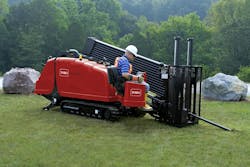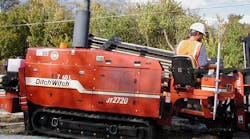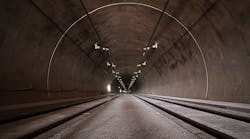Horizontal directional drilling (HDD) was introduced in the late 1980s; the process was not an overnight success. Drill manufacturers spent the initial years explaining to skeptical contractors the potential benefits of using a machine that could install underground infrastructure—whether gas lines, water pipes, electrical conduits, or large-diameter pipelines—without leaving much surface evidence of having done so.
Then, a few years later, a boom in the telecom industry had manufacturers scrambling to keep up with the demand for rigs. When the boom turned bust in the early 2000s, so did the fortunes of the HDD industry, not only in diminished machine sales, but also in reputation, which suffered because of shoddy work done by inexperienced contractors who wanted to cash in on the boom but really should have stuck to the work they knew.
The use and reputation of HDD, however, has been gaining ground since then.
“In the early days of HDD,” says Richard Levings, director of product management, American Augers, “trenchers, plows, and excavators were doing most utility installations, with an HDD unit used perhaps to get under streets and driveways. Today, with congested easements and the high cost of open-trench excavation—including the social costs of disrupting business and day-to-day activity—HDD is the preferred method of placing all manner of utilities in urban areas.”
Market Cross-Section
Manufacturer # of models Thrust/pullback (lb.) Rotational torque (lb.-ft.) American Auger 6 110,000-1,100,000 15,000-100,000 Ditch Witch 11 5,000-100,000 500-12,000 Herrenknecht Std., custom 180,000-1,100,000 44,250-103,300 McLaughlin* 2 17,660 1,030 Prime Direct Custom 67,500-1,349,000 13,000-133,000 Toro 2 20,000-40,000 2,400-5,000 Vermeer 16 5,500-1,360,000 550-102,500 *Models are pit-launched, available in 5-foot and 7-foot versions, and are designed for short bores (up to 250 feet) and have 13,250 pounds of pullback force for handling backreamers up to 12 inches in diameter.
As HDD becomes a mainstream technique, drill manufacturers—as well as suppliers of down-hole tools, bore-tracking/bore-planning systems, and drilling fluids—have significantly advanced HDD technology, allowing longer, deeper, more accurate bores through the most difficult materials, all the while more safely avoiding the infrastructure already in place.
HDD machines are available today with a wide range of capabilities. At the small end are those having less than 20,000 pounds of thrust/pullback and dimensions compact enough to allow working unobtrusively in residential neighborhoods—such as the Ditch Witch JT5, McLaughlin MCL 10H, and Toro DD2024.
At the other end of the spectrum are giant rigs having thrust/pullback forces exceeding one million pounds and capable of installing product exceeding 60 inches in diameter, such as the American Augers DD-1100RS, Vermeer D1320 x 900, the largest Prime Direct models, which, says the company’s Bill Brennan, are custom-built to customer specification, as are the largest Herrenknecht models that are available in frame, trailer, crawler, and modular versions, says Dipl.-Ing (FH) Michael Lubberger, senior project manager pipeline, Herrenknecht AG.
Some of these large rigs reportedly have accomplished bores exceeding two miles, but those long installations are the exception. Construction Equipment asked Vermeer’s Tod Michael, product manager, core products, about the longest bore practical with the company’s largest rigs, and the answer was around 6,000 feet. In fact, says American Augers’ Levings, owners of projects requiring exceptionally long bores might require two large rigs on site to reduce the prospect of mishap.
“Most long bores today are intersected,” says Levings. “On a 10,000-foot bore, for example, rigs drilling from either end meet in the center to mitigate the risk of ‘frac-out.’ The longer a machine goes into the bore, the more difficult it is for the drilling fluid to move cuttings all the way back to the surface, and down-hole pressure can increase. The use of two rigs, in effect, shortens the pilot bore and the distance that cuttings must be moved.”
(If pressure in the bore exceeds that of the overburden above, the drilling fluid escapes by the path of least resistance, usually by “fracturing” the overburden and spilling out on the surface.)
According to Herrenknecht’s Lubberger, when the company’s new Down Hole Jet Pump—which removes bore cuttings directly inside the drill string—is installed behind the company’s Full-Face Hole Opener, “the risk of frac-out is significantly reduced.” The Full-Face Hole Opener, he says, can open bores to 72 inches.
Markets
At present, HDD contractors who specialize in optical-fiber and gas/electric installations, as well as those involved in replacing substandard water-distribution systems, seem to have ample work. For example, according to the Fiber To The Home (FTTH) Council, an organization that promotes bringing fiber-optic lines directly to the house, only one in five U.S. households presently have access to fiber-optics—and the other four are wishing they had it. (Fiber-optic lines carry immensely more data than can copper wire, speeding the transmission process.)
“Small HDD rigs are easily the most popular units in the marketplace today,” says Josh Beddow, marketing manager, Toro. “Growth in this market has been fueled by a strong telecom industry, as well as by an increased demand for gas and electric installation, driven by residential construction. These markets, plus the need to replace aging infrastructure, have made directional drills an extremely popular solution where excavation or trenching isn’t practical or cost-effective due to rehabilitation requirements.”
Seth Matthesen, senior project manager, HDD, Ditch Witch, agrees, and sees what might be viewed as balancing forces in the market.
“Year over year, the drill market has seen increases, particularly in drills under 25,000 pounds [thrust/pullback],” says Matthesen. “The fiber sector remains strong, which is creating a demand for more and more HDD projects. While the oil and gas market continues to soften at this point, the growth in smaller drill units has made up for any losses in this market space.”
American Augers’ Levings, however, is somewhat optimistic about the oil and gas markets.
“The type of equipment we manufacture is designed for large projects that typically involve long distances and large-diameter product, primarily focused on oil, gas, and petrochemical pipelines,” says Levings. “While this type of work has been slow or absent for many in the past 18 months or so, recent months have shown progress in the number of project starts. The industry is healing, and work is beginning. But for the OEM [of HDD machines], sales are slow, because the backlog of work is less than in the past.”
Perhaps also supporting the market for the very largest HDD models are nervous project owners.
“There are projects, for example,” says Levings, “that could easily be handled by our DD-440RS [600 horsepower, 440,000 pounds thrust/pullback]. “But given the time constraints on most large HDD projects, the owner might choose to have a DD-1100RS doing the work [765 horsepower, 1.1 million pounds thrust/pullback]. The owner and designer are trying to mitigate risks and believe that bigger is better.”
On the smaller-machine side, Ditch Witch’s Matthesen notes that the demand for used and refurbished machines is continuing.
“Many contractors new to the HDD market are looking for used drills to get started,” he says, “and those contractors with a tenured operation might need a spare drill, which won’t be used full time, and might opt to utilize the used market.”
Toro’s Beddow agrees that the used market is strong, but notes that the historically healthy market for these machines outside of North America and Europe must now deal with the problem of proper fuel for machines that meet the latest emissions standards.
Contractor challenges
Business is good for many HDD contractors today, but that success is not without challenges.
“HDD contractors face a number of challenges today,” says Vermeer’s Michael, “including buried-utility congestion, locator interference, small right-of-ways, increasing regulation, disposing of drilling fluids, and work-force restraints in terms of the number of trained drillers available.”
The short supply of qualified drill operators has become a significant issue in the HDD industry, and manufacturers are implementing programs to address the problem, including Ditch Witch’s “We Get Crews Ready” program—which entails online education, 40 hours of practical technology application at a dealer, and supervision on an actual work site—and Vermeer’s HDD Circuit Training program—a comprehensive, two-week program at the company’s headquarters.
Prime Direct’s Brennan says that the sheer capability of today’s HDD rigs has its own challenges.
“Today’s large machines are capable of longer bores, more accurate bores, with larger diameters and in tougher materials—bores that would have been impossible 10 years ago,” says Brennan. “But these factors also elevate risks, such as that of frac-out.”
But on any size project and with any size machine, says Toro’s Beddow, a continuing challenge for contractors is taking time out for proper machine maintenance, a practice easily overlooked by busy contractors wanting as much production as possible from their rigs.
As Vermeer’s Michael noted, the disposal of used drilling fluid is becoming acute for contractors. Levings cites a Texas contractor who 12 months ago had 30 disposal sites, but now has only two. The industry is responding to this issue, says Levings, with more advanced fluid-cleaning systems, some of which allow working to completion on long bores without interruption to dispose of fluid. Newer systems, he says, can process used fluid back to clean water and dry tailings, which are much easier to handle.





